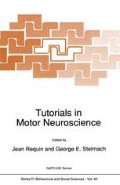Abstract
Conventional views of motor control, which state or imply that it is a deterministic system, are being challenged by the recognition that the stochastic properties of motor control may offer clues to some of its operations. This paper considers evidence that there exists a general property of trajectory formation which is a consequence of the inherent variability of movements. Specifically, the amplitude of the initial sub-movement of motions containing two or more such sub-movements is planned so as to take into account its spatial variability. Examples are given of cases where such a principle might be expected to apply, and the usefulness of this phenomenon for examining individual and strategy differences in aiming tasks is discussed.
Access this chapter
Tax calculation will be finalised at checkout
Purchases are for personal use only
Preview
Unable to display preview. Download preview PDF.
References
Annett, J., Annett, M., Hudson, P.T.W., & Turner, A. (1979). The control of movement in the preferred and non-preferred hands. Quarterly Journal of Experimental Psychology. 31, 641–652.
Brooks, V.B. (1985). How are “move” and “hold” programs matched? In H.J. Dichgans, W.J. Bloedel,, and W. Precht, (Eds.) Proc. life sciences. Berlin: Springer Verlag, pp. 1–23.
Carlton, L.G. (1979). Control processes in the production of discrete aiming responses. Journal of Human Movement Studies. 5, 115– 124.
Darling, W.G. & Cooke, J.D. (1987a). Changes in the variability of movement trajectories with practice. Journal of Motor Behavior. 19, 291–309.
Darling, W.G. & Cooke, J.D. (1987b). Movement related EMGs become more variable during learning of fast accurate movements. Journal of Motor Behavior. 19, 311–331.
Darling, W.G. (1989) Neural mechanisms underlying motor output variability. In C.J. Worringham (Ed.) (1989). Spatial. temporal and electromyographical variability in human motor control (Proceedings of a symposium held in Ann Arbor, Michigan, 17–18 February, 1989, pp. 10–13.
Fetters, L. & Todd, J. (1987). Quantitative assessment of infant reaching movements. Journal of Motor Behavior, 19, 147–166.
Gordon, J., & Ghez, C. (1987). Trajectory control in targeted force impulses. III. Compensatory adjustments for initial errors. Experimental Brain Research. 67, 253–269.
Hollerbach, J.M. (1982). Dynamic interactions between limb segments during planar arm movement. Biological Cybernetics, 39, 139– 156.
Keele, S.W. (1968). Movement control in skilled motor performance. Psychological Bulletin. 70, 387–403.
Marteniuk, R.G. & Romanow, S.K.E. (1982). Human movement organization and learning as revealed by variability of movement, use of kinematic information and Fourier analysis. In R.A. Magill (Ed.) Memory and Control of Action, Amsterdam: North-Holland.
Meyer, D.E., Smith, J.E.K., & Wright, C.E. (1982). Models for the speed and accuracy of aimed movement. Psychological Review. 89, 449–482.
Meyer, D.E., Abrams, R.A., Kornblum, S., Wright, C.E. & Smith, J.E.K. (1988). Optimality in human motor performance: Ideal control of rapid aimed movements. Psychological Review, 95, 340–370.
Meyer, D., Smith, J.E.K., Kornblum, S., Abrams, R.A., & Wright, C.E. (1989). Speed-accuracy tradeoffs in aimed movements: Towards a theory of rapid voluntary action. In M. Jeannerod (Ed.) Attention and Performance XIII, Hillsdale, NJ: Lawrence Erlbaum.
Moore, S. & Marteniuk, R.G. (1986). Kinematic and electromyographic changes that occur as a function of learning a time - constrained aiming task. Journal of Motor Behavior. 18, 397– 426.
Pélisson, D., Prablanc, C., Goodale, M.A., & Jeannerod, M. (1986). Visual control of reaching movements without vision of the limb. II. Evidence of fast unconscious processes correcting the trajectory of the hand to the final position of a double-step stimulus. Experimental Brain Research, 62, 303–311.
Rosenbaum, D. (1980). Human movement initiation: Specification of arm, direction, and extent. Journal of Experimental Psychology: General. 109, 444–474.
Schmidt, R.A., Zelaznik, H.N., Hawkins, B., Frank, J.S., & Quinn, J.T. (1979). Motor output variability: A theory for the accuracy of rapid motor acts. Psychological Review, 86, 415– 451.
Schmidt, R.A., Sherwood, D.E., Zelaznik, H.N., & Leikind, B.J. (1985). Speed-accuracy trade-offs in motor behavior: Theories of impulse variability. In H. Heuer, U. Kleinbeck, & K.-H. Schmidt (Eds.), Motor behavior: Programming control, and acquisition (pp. 79–123). Berlin: Springer Verlag.
Soechting, J.F. (1984). Effect of target size on spatial and temporal characteristics of a pointing movement in man. Experimental Brain Research. 54, 121–132.
Taylor, F.V., & Birmingham, H.P. (1948). Studies of tracking behavior, II: The acceleration pattern of quick manual corrective responses. Journal of Experimental Psychology, 28, 783–795.
Todor, J.I., & Cisneros, J. (1985). Accomodation to increased accuracy demands by the right and left hands. Journal of Motor Behavior. 17, 355–372.
Tsiboulevsky, I.E. (1981). Notes on the theory of the accuracy of rapid movements proposed by R. Schmidt and co-authors. (R. Browning, trans.) Voprosy Psikhologii. No. 3, 127–131.
Waters, P., & Strick, P.L. (1980). Influence of “strategy” on muscle activity during ballistic movements. Brain Research. 207, 189–197.
Welford, A.T. (1968). The fundamentals of skill. London: Methuen.
Welford, A.T. (1984). Between bodily changes and performance: some possible reasons for slowing with age. Experimental Aging Research. 10, 73–88.
Woodworth, R.S. (1899). The accuracy of voluntary movement. psychological Review, 3, 1–114.
Worringham, C.J. (Ed.) (1989). Spatial, temporal and electromyographical variability in human motor control (Proceedings of a symposium held in Ann Arbor, Michigan, 17 - 18 February, 1989.
Worringham, C.J. (1991). Variability effects on the internal structure of rapid aiming movements. Journal of Motor Behavior (in press).
Wright, C.E., & Meyer, D.E. (1983). Conditions for a linear speed-accuracy trade-off in aimed movements. Quarterly Journal of Experimental Psychology: Human Experimental Psychology, 35A, 279–296.
Zelaznik, H.N., Shapiro, D.C., & McColsky, D. (1981) Effects of a secondary task on the accuracy of single aiming movements. Journal of Experimental Psychology: Human Perception and Performance, 7, 1007–1018.
Author information
Authors and Affiliations
Editor information
Editors and Affiliations
Rights and permissions
Copyright information
© 1991 Springer Science+Business Media Dordrecht
About this chapter
Cite this chapter
Worringham, C.J. (1991). The Integration of “Noise” into the Structure of Movements. In: Requin, J., Stelmach, G.E. (eds) Tutorials in Motor Neuroscience. NATO ASI Series, vol 62. Springer, Dordrecht. https://doi.org/10.1007/978-94-011-3626-6_35
Download citation
DOI: https://doi.org/10.1007/978-94-011-3626-6_35
Publisher Name: Springer, Dordrecht
Print ISBN: 978-94-010-5609-0
Online ISBN: 978-94-011-3626-6
eBook Packages: Springer Book Archive

